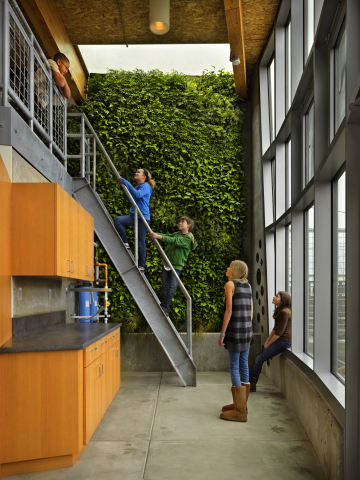
by Shane Henson — April 26, 2013—Bertschi School, an independent elementary school in the Capitol Hill neighborhood of Seattle, Washington, is now home to the first Living Building on the West Coast and the world’s fourth fully certified Living Building.
A program of the International Living Future Institute, the Living Building Challenge (LBC) is widely considered the world’s most rigorous building performance standard. A Living Building generates all of its own energy through clean, renewable resources; captures and treats its own water; incorporates only non-toxic, appropriately sourced materials; and operates efficiently and for maximum beauty. A building must perform as designed for one full year of occupancy and pass a third-party audit before receiving certification as “Living,” says the ILFI.

The Bertschi School’s many sustainable features include an interior living wall of tropical plants, or “greenwall.”
Completed in February 2011, Bertschi’s Living Building Science Wing is a 3,380-square-foot interactive learning environment for students ages 5-11. It is the first built project to meet the standards of version 2.0 of the Living Building Challenge, a green building certification program that integrates urban agriculture, social justice and universal access issues, and the use of healthy building materials.
Conceptualized with significant teacher and student input, the Science Wing serves as the ultimate tool for teaching science and sustainability. The building’s sustainable features are visible and functional to foster dynamic learning opportunities. It is net-zero energy and water: a 20-kilowatt photovoltaic system provides all of the electricity, and cisterns collect rainwater that is used for irrigation and flushing the composting toilet. Excess captured water is absorbed by the on-site rain garden. Other water-saving features include a green roof and an interior living wall of tropical plants, which treats all of the building’s grey water.
Students are able to learn about sustainability through walking around the school’s grounds as well. The Bertschi School’s Science Wing sits on an urban site with an ethnobotanical garden that serves as an outdoor classroom. With its indigenous northwest plants, the garden enables students to learn about native culture and history, as well as use plant material in their art classes, such as berries for paint dyes and grasses used to fashion paint brushes. Food produced in this garden—and in the neighboring vegetable garden on-site—helps educate students about the values of organic farming and growing food.
The design of the Science Wing derived from a partnership between Bertschi School and the Restorative Design Collective, a multidisciplinary team led by KMD Architects and comprised of leading Pacific Northwest green building professionals. The Collective contributed their design services pro bono, with donations amounting to more than $500,000 in professional time and building materials.





